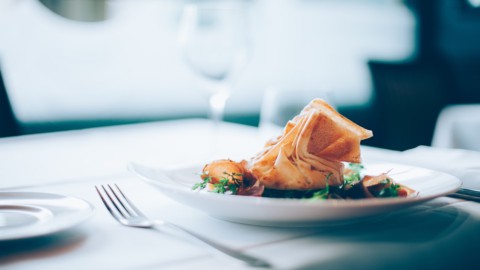There is something new in the Italian food and wine scene, a world in great effervescence and evolution. The Gambero Rosso 2017 Restaurant Guide focuses this situation well by presenting next to the names of the Gotha of Italian catering, what is moving. Thus, among the 2420 addresses of good food in Italy reported this year, there are 300 new entries, as if to say: be careful, in this sector Italy is all about becoming and it is good to venture into new discoveries of taste, sensations and flavours.
However, the first novelty that emerges from this year's Gambero Rosso Guide is that the maximum recognition of the three forks has increased by four new units. In all, the Olympus of Italian catering now consists of 29 Chefs that the world envies us. Massimo Bottura of L'Osteria Francescana in Modena is firmly at the top of the pyramid together with Heinz Beck of the Pergola of the Rome Cavalieri hotel. Followed by Antonino Cannavacciuolo of Villa Crespi in Orta San Giulio; Alfonso Iaccarino of Sant'Agata sui due Golfi; Gennarino Esposito of the Torre del Saracino in Vico Equense; Enrico Crippa of Piazza Duomo in Alba; Antonio and Nadia Santini of the Dal Pescatore restaurant in Canneto Sull'Oglio; Antonio Guida del Seta of the Mandarin Oriental in Milan; Massimiliano Alajmo of Le Calandre in Rubano; Fabrizia Merok and Roberto Brovedan of Laite di Sappada; Norbert Niederkofler of the Sant Hubertus of the Hotel Rosa Alpina in San Cassiano; Gioacchino Pontrelli of Lorenzo of Forte dei Marmi; Mauro Uliassi from Senigallia; Niko Romito of Reale in Castel di Sangro; Victor of Brusaporto; Ilario Vinciguerra of Gallarate; Andrea Berton in Milan; The Siriola of the Ciasa Salares hotel in San Cassiano; the Pinchiorri Enoteca in Florence; The Madonnina del Pescatore of Senigallia; Vissani House of Baschi; The Trout of Rivodutri; The Estia Tavern in Brusciano; The Madia di Licata with the great Pino Cuttaia; Roman of Viareggio; The Ciociarian hills of Acuto; Pascucci at the Port of Fiumicino; Four steps of Massa Lubrense; S'apposentu di casa Puddu di Siddi.
In short, the choices of this year's Guide "photograph - says its director Giancarlo Perrotta - a complex and varied cuisine from year to year that is more difficult to enclose in closed categories as it is rich in stimuli, talents, ideas, as solid in its roots" .
Big names yes, new entrances yes, but the new one reported by Gambero Rosso also extends to venues that they can represent a first step for those who want to embark on a journey of quality cooking without passing out, looking for the right quality/price ratio which, in these times, times of sacrifices and hardships for the Italian family, is not much to underestimate.
And therefore, next to the high-sounding names of the restaurant industry that make your wrists and wallet tremble, here is the indication of trattorias, wine bars, breweries, ethnic venues. Among these, one section of prizes appears particularly interesting – the Guides are also used for this – and it is the one for the “best quality/price”. Surprises abound: 21 restaurants scattered throughout Italy where the quality is high but where you can sit without passing out even starting from an incredible minimum of €20 in a Cagliari restaurant (“The inn of good and bad”) passing through the €30 “Da Fausto” in Cavatore (AL), for the €35 of “Il foro dei Baroni” in Pugnianello (BN) and “L'Officina” in Perugia; to reach a maximum of €50 for “D'O” from Cornaredo (MI), which also received the “Novelty of the Year” award.
Always with the intention of giving the consumer an indication, "so that the choice of how to spend your money in a restaurant is thoughtful and aware" as stated in the introductory page of this year's Guide, it is the category of "Three Shrimps" which rewards the best taverns, still a useful indication for eating with taste and at acceptable costs. And so here are the awards among others to the "Consortium" of Turin; at La “Brinca” di Ne in the province of Genoa; at the "Madia" of Brione (Brescia); at the "Osteria Bottega" in Bologna; at the "Capanno" of Spoleto; to “Sora Maria e Arcangelo” by Olevano Romano which is worth a trip from Rome; the "Old Marina" of Roseto degli Abruzzi; "Angiolina" of Pisciotta in the province of Salerno; "Ancient Flavors" of Andria; Tischi Toschi's “Locandiera” in Taormina.
To conclude, “restaurants are doing well in Italy – Giancarlo Perrotta comments with satisfaction – we are among the best, they say it almost everywhere in the world. In short, cooking and wine are all the rage today – just turn on the TV – and they even become spectacular with the approval of some chefs. So after a population of 60 million football coaches, today we are 60 million food and wine critics (the very good ones) and we talk about barriques, aftertaste, low temperature, vacuum packing, sometimes taking ourselves too seriously and losing sight of the ultimate goal of the conversation: service to the reader”.
All that remains is to navigate through the various categories of notifications: "Forks", "Shrimps", "Bottles" (for restaurants with a large cellar), "Boccali" for breweries, "Global Globes" for fish cuisines; “Cocotte” for the Bistros, “Best price quality”, “Best dining room service”, “Taste and health” for the promotion of the territory and its products, “Best proposal of pasta dishes” to navigate in that magnum sea of flavors and tastes that represent a food and wine heritage unique in the world that today the world has discovered and asks us with greater insistence.





